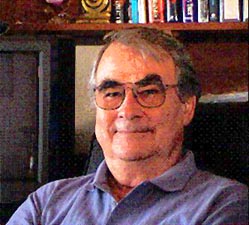


 |
 |
 |


Born in Worcester, MA in 1935. Attended Worcester Polytechnic Institute graduating in 1957 with a BSEE degree. Also received a commission in the US Army Signal Corps from the ROTC program at WPI.
Served for 2 years in the Army, 1958-1960, at Fort Monmouth, NJ and Fort Bliss, TX and was discharged as a Radar and Countermeasures Equipment Repair Officer.
Hired in 1960 by Edgerton, Germeshausen and Grier (EG&G) in Las Vegas, NV to work on a Radar range at Groom Lake, NV. Participated in the design, buildup and operation of both a ground and flight radar range to verify the Radar Cross Section of the A-12 Blackbird aircraft. After the A-12 was deployed to Kadena AFB in Okinawa the ranges were shut down in 1967-68 and I transferred to the Nevada Test Site. I was in charge of Timing and Firing support for Lawrence Livermore Laboratory until 1971.
In 1972 I went to work for Global Marine Development Incorporated (GMDI) as an electrical engineer in the program office for the Hughes Glomar Explorer. In 1975 Jack Anderson, an investigative reporter, reported that the Glomar Explorer was recovering a Russian submarine in the Pacific and not performing ocean mining as advertised. The project was terminated.
In 1976 I was hired by Lockheed Aircraft Corporation (LAC) to perform the Low Observable testing on the Experimental Survivable Testbed (XST) Have Blue aircraft at Groom Lake. (See http://www.f-117a.com/XST.html) I continued in that capacity through 1996 on all of the LAC Stealth vehicles. In 1996 I transferred to the LAC Helendale Test Facility, which is the Skunk works ground range radar test facility. I managed that facility until I retired in 2000.
The Roadrunners of Area 51 are saddened by the final flight of Wayne E. Pendleton. Wayne suffered sub dural hemorrhage on Feb 29th followed by a carniotomy to remove a massive blood blob.
Born in Worcester, MA in 1935, Wayne Attended Worcester Polytechnic Institute graduating in 1957 with a BSEE degree. He received a commission in the US Army Signal Corps from the ROTC program at WPI.
Wayne served for 2 years in the Army, 1958-1960, at Fort Monmouth, NJ and Fort Bliss, TX and was discharged as a Radar and Countermeasures Equipment Repair Officer.
In 1960, Edgerton, Germeshausen and Grier (EG&G) in Las Vegas, NV hired Wayne to work on a Radar range at Groom Lake, NV. He participated in the design, buildup and operation of both a ground and flight radar range to verify the Radar Cross Section of the A-12 Blackbird aircraft. After the A-12, deployed to Kadena AFB in Okinawa the ranges shut down in 1967-68, he transferred to the Nevada Test Site in charge of Timing and Firing support for Lawrence Livermore Laboratory until 1971.
In 1972, he went to work for Global Marine Development Incorporated (GMDI) as an electrical engineer in the program office for the Hughes Glomar Explorer. In 1975 Jack Anderson, an investigative reporter, reported that the Glomar Explorer was recovering a Russian submarine in the Pacific and not performing ocean mining as advertised. The project was terminated.
In 1976, Lockheed Aircraft Corporation (LAC) hired Wayne to perform the Low Observable testing on the Experimental Survivable Testbed (XST) Have Blue aircraft at Groom Lake. He continued in that capacity through 1996 on all of the LAC Stealth vehicles. In 1996, he transferred to the LAC Helendale Test Facility, which is the Skunk works ground range radar test facility. He managed that facility until he retired in 2000.
 |
 |
 |